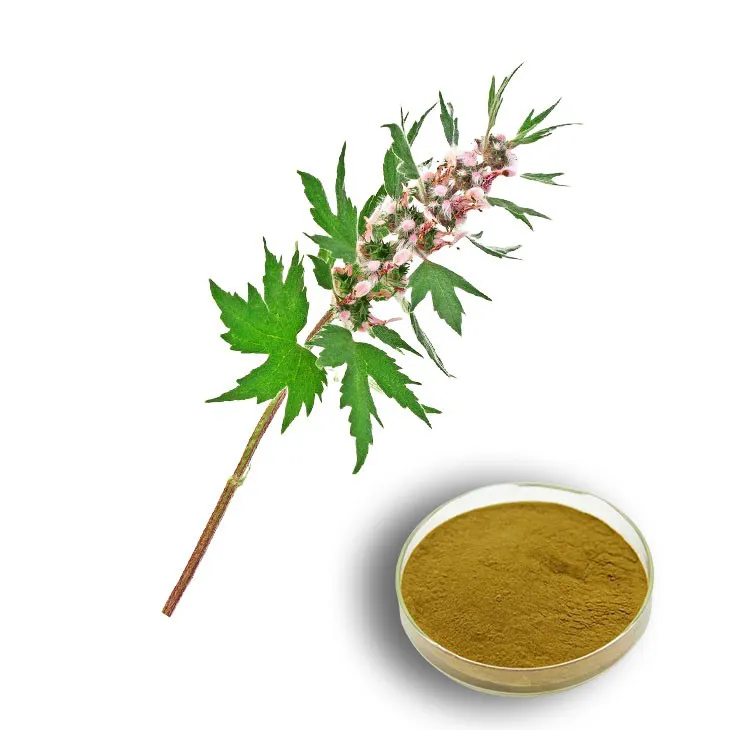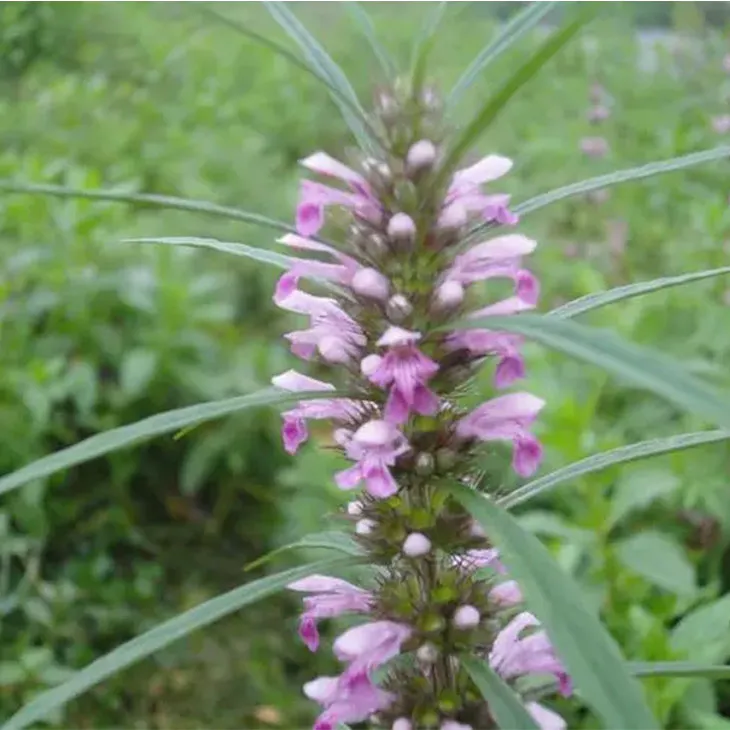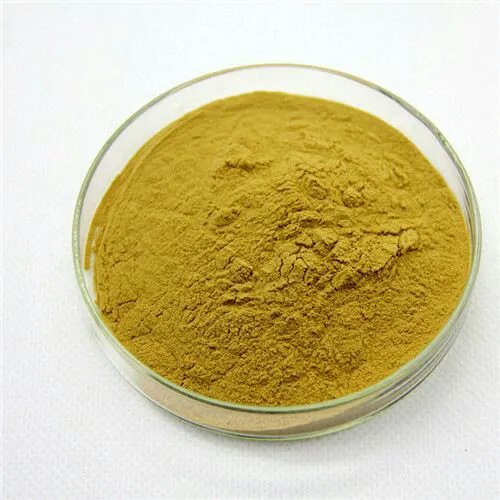- 0086-571-85302990
- sales@greenskybio.com
Components of Motherwort Extract in Fertilizers and Feeds.
2024-11-29

1. Introduction to Motherwort Extract
Motherwort (Leonurus cardiaca) has been used in traditional medicine for centuries. Extracts from motherwort are now emerging as a potentially valuable ingredient in fertilizers and animal feeds. Motherwort is a herbaceous plant that is rich in various bioactive compounds. The extract is obtained through different extraction methods, such as solvent extraction, which can isolate the beneficial components for further use in agricultural and livestock applications.

2. Composition of Motherwort Extract
2.1 Alkaloids
One of the major groups of compounds in Motherwort Extract is alkaloids. These alkaloids play important roles in both plant and animal systems. For example, leonurine, an alkaloid present in motherwort, has been shown to have antioxidant properties. In plants, alkaloids can act as natural pesticides, protecting the plants from pests and diseases. In animal feeds, certain alkaloids may have positive effects on the animals' physiological functions. They can potentially influence the metabolism and immune system of animals, contributing to better health and growth.
2.2 Flavonoids
Flavonoids are another significant component of motherwort extract. Flavonoids are well - known for their antioxidant and anti - inflammatory properties. In the context of fertilizers, flavonoids can enhance the soil structure. They can interact with soil particles, improving soil aggregation and water - holding capacity. In animal feeds, flavonoids can improve the antioxidant status of animals. This can lead to reduced oxidative stress in animals, which is beneficial for their overall well - being. For instance, flavonoids may help in protecting the animals' cells from damage caused by free radicals.
2.3 Terpenoids
Terpenoids in motherwort extract also contribute to its potential applications. Terpenoids have diverse biological activities. In plants, they can be involved in plant - plant communication and defense mechanisms. When used in fertilizers, terpenoids may help in promoting root growth. They can stimulate root elongation and branching, which in turn improves nutrient uptake by plants. In animal feeds, terpenoids may have antimicrobial properties. This can help in reducing the growth of harmful microorganisms in the digestive tract of animals, promoting better digestion and nutrient absorption.

3. Motherwort Extract in Fertilizers
3.1 Enhancement of Plant Growth
The various components of motherwort extract work together to enhance plant growth. The alkaloids, flavonoids, and terpenoids can have synergistic effects. For example, the antioxidant properties of flavonoids and alkaloids can protect plants from oxidative damage caused by environmental stresses such as drought and high temperature. At the same time, terpenoids can promote root development, allowing plants to access more nutrients and water from the soil. This combined effect can lead to increased plant height, leaf area, and overall biomass production.
3.2 Improvement of Nutrient Uptake
Motherwort extract can also improve nutrient uptake in plants. The presence of certain compounds in the extract can chelate with soil nutrients, making them more available for plant uptake. For instance, flavonoids can form complexes with metal ions in the soil, such as iron and zinc. These complexes are more easily absorbed by plant roots compared to the free ions. Additionally, the improved root growth promoted by terpenoids can also increase the surface area of roots for nutrient absorption.
3.3 Role in Soil Health
In terms of soil health, motherwort extract has multiple benefits. As mentioned earlier, flavonoids can improve soil structure. This can enhance soil aeration and water infiltration, creating a more favorable environment for soil microorganisms. The presence of motherwort extract in the soil can also stimulate the growth and activity of beneficial soil bacteria and fungi. These microorganisms play crucial roles in nutrient cycling, decomposition of organic matter, and suppression of soil - borne diseases.

4. Motherwort Extract in Animal Feeds
4.1 Nutritional Value Enhancement
When added to animal feeds, motherwort extract can enhance the nutritional value. The bioactive compounds in the extract can provide additional health benefits to animals. For example, the antioxidants in the extract can help in maintaining the quality of animal products such as meat, milk, and eggs. They can prevent lipid peroxidation in these products, which can lead to off - flavors and reduced shelf - life. Moreover, the alkaloids and flavonoids may have positive effects on the animals' internal organs, improving their function and contributing to better overall health.
4.2 Health Promotion in Animals
Motherwort extract can also promote the health of animals. The antimicrobial properties of terpenoids can help in preventing infections in animals. This is especially important in livestock rearing, where diseases can cause significant economic losses. The anti - inflammatory properties of flavonoids can also reduce inflammation in animals' bodies, which is beneficial for their long - term health. Additionally, the alkaloids may have an impact on the animals' hormonal balance, which can influence their growth and reproduction.

5. Importance in Sustainable Farming and Livestock Rearing
The use of motherwort extract in fertilizers and feeds has important implications for sustainable farming and livestock rearing. In sustainable farming, the use of natural plant - based extracts like motherwort can reduce the reliance on synthetic fertilizers. This can have a positive impact on the environment by reducing chemical runoff and soil degradation. In livestock rearing, the addition of motherwort extract to feeds can reduce the need for antibiotics and other synthetic additives. This can lead to the production of healthier and more sustainable animal products.
6. Challenges and Future Directions
6.1 Standardization of Extract
One of the main challenges in using motherwort extract is the standardization of the extract. The composition of motherwort extract can vary depending on factors such as the plant source, extraction method, and growing conditions. This variation can make it difficult to ensure consistent quality and efficacy in fertilizers and feeds. Future research should focus on developing standardized extraction methods and quality control measures to overcome this challenge.
6.2 Safety and Toxicity Studies
Although motherwort has a long history of use in traditional medicine, more comprehensive safety and toxicity studies are needed when it is used in fertilizers and feeds. It is important to determine the maximum safe dosage levels for different animals and plants. There is also a need to study the potential long - term effects of motherwort extract on the environment, animals, and plants. These studies will help in ensuring the safe and sustainable use of motherwort extract in agricultural and livestock applications.
6.3 Optimization of Application
Another area for future research is the optimization of the application of motherwort extract in fertilizers and feeds. This includes determining the optimal dosage, application frequency, and combination with other ingredients. By optimizing the application, the full potential of motherwort extract can be realized in promoting plant growth and animal health, while also minimizing any potential negative impacts.
7. Conclusion
Motherwort extract is a promising ingredient in fertilizers and feeds. Its rich composition of alkaloids, flavonoids, and terpenoids offers multiple benefits for plant growth, nutrient uptake, soil health, and animal health. However, there are still challenges to be addressed, such as standardization, safety, and optimization of application. With further research and development, motherwort extract has the potential to play an important role in sustainable farming and livestock rearing, contributing to the production of healthier and more environmentally friendly agricultural products.
FAQ:
What are the main components of motherwort extract?
The main components of motherwort extract may include various bioactive substances such as alkaloids, flavonoids, and phenolic compounds. These components play important roles in its potential functions in fertilizers and feeds.
How does motherwort extract enhance plant growth?
Motherwort extract can enhance plant growth in several ways. The bioactive components may stimulate root development, which in turn helps plants absorb more water and nutrients from the soil. It may also have some hormonal - like effects that promote overall plant growth and development.
What benefits does motherwort extract bring to soil nutrient uptake?
Motherwort extract can improve soil nutrient uptake. It may interact with the soil microorganisms, enhancing their activity. These microorganisms can then help in the breakdown and release of nutrients in the soil, making them more available for plant uptake.
How can motherwort extract improve the nutritional value of animal feed?
The bioactive components in motherwort extract can have positive effects on animal health. For example, some components may improve digestion in animals. By enhancing digestion, animals can better absorb nutrients from the feed, thereby increasing the nutritional value of the feed.
Is motherwort extract safe for use in fertilizers and feeds?
When used appropriately, motherwort extract is generally considered safe for use in fertilizers and feeds. However, like any ingredient, proper dosage and quality control are essential. Extensive research is usually carried out to ensure its safety and effectiveness in these applications.
Related literature
- Analysis of the Active Components in Motherwort Extract for Agricultural Applications"
- "The Role of Motherwort Extract in Sustainable Feed Formulations"
- "Motherwort Extract: A Promising Ingredient for Soil - Enhancing Fertilizers"
- ▶ Hesperidin
- ▶ citrus bioflavonoids
- ▶ plant extract
- ▶ lycopene
- ▶ Diosmin
- ▶ Grape seed extract
- ▶ Sea buckthorn Juice Powder
- ▶ Beetroot powder
- ▶ Hops Extract
- ▶ Artichoke Extract
- ▶ Reishi mushroom extract
- ▶ Astaxanthin
- ▶ Green Tea Extract
- ▶ Curcumin Extract
- ▶ Horse Chestnut Extract
- ▶ Other Problems
- ▶ Boswellia Serrata Extract
- ▶ Resveratrol Extract
- ▶ Marigold Extract
- ▶ Grape Leaf Extract
- ▶ blog3
- ▶ blog4
-
The Most Highly - Praised Lavender Extract.
2024-11-29
-
Organic Goldenseal Extract Powder Suppliers.
2024-11-29
-
Standard - process pine bark extract powder.
2024-11-29
-
Nature's Bounty Almond Powder
2024-11-29
-
Organic Taurine Powder Suppliers.
2024-11-29
-
Bulk purchase of black pepper extract.
2024-11-29
-
Fig Extract
2024-11-29
-
Dandelion Leaf Extract
2024-11-29
-
Sea buckthorn Juice Powder
2024-11-29
-
Konjac Powder
2024-11-29
-
Fenugreek Extract Powder
2024-11-29
-
Shikone Extract
2024-11-29
-
Maitake Mushroom Extract
2024-11-29
-
Polygonum multiflorum extract
2024-11-29
-
Artichoke Extract
2024-11-29
-
Cranberry Extract
2024-11-29





















